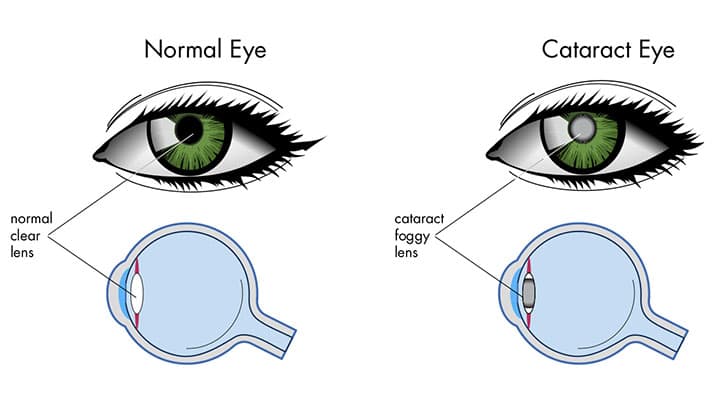
Cataract Meaning
A cataract is a clouding of the eye’s lens, the clear, oval-shaped structure that rests behind the pupil inside every eye.
Most cataracts occur as a result of getting older, usually sometime after age 40. As we age, the proteins that help make up the lens can start to clump together, which causes the clouding.
Cataracts are the most common cause of vision loss worldwide, but the good news is that they are treatable.
How cataracts affect your vision
Cataracts usually develop in both eyes, but sometimes they only affect one.
When both eyes are affected, cataracts can progress at a different rate in each eye, resulting in visual symptoms in one eye and normal vision in the other.
A cataract won’t affect your vision in the beginning. Visual symptoms can take months to years to become noticeable.
Symptoms of cataract
Cataracts can make your vision appear blurry, cloudy, hazy or dim. Some cataracts cause colors to appear less vibrant and yellowed, like a sepia-tone photo.
Additionally, symptoms of cataracts can include:
- Light sensitivity
- Increasing difficulty seeing at night or in low light
- Double vision
- Visual halos around bright lights
To the outside viewer, an advanced cataract can cause the pupil to appear light gray instead of black.
 Common types of cataracts
Common types of cataracts
There are many cataract types, but a few are much more common than the others.
Nuclear cataracts are the most common form of cataract. These form in the center of the eye’s lens, gradually worsening and affecting vision.
Cortical cataracts usually are spoke-like opacities that begin near the edge of the lens and grow toward its center. These make you experience more light glare, making night driving particularly difficult.
Posterior subcapsular cataracts develop at the central back surface of the lens. These tend to develop much more quickly than the others, specifically affecting your vision around bright light and colors.
Diagnosing and treating cataracts
Eye doctors can use different tests to diagnose cataracts. These include:
Slit-lamp exam
A slit lamp is a large, binocular microscope with a bright light source that’s mounted on a small table. It enables your eye doctor to closely examine your eye under high magnification (including checking the lens for cataracts).
Retinal exam
First, an eye doctor will dilate your eyes with eye drops, causing the pupils to slowly open. This gives the doctor a much better view inside your eye. The doctor then examines the retina and optic nerve in the back of your eye. A dilated eye exam also provides the best view of any cataract formation on the lens.
Refraction
During a refraction, your eye doctor determines the degree of your refractive errors and the eyeglass prescription that provides your best possible visual acuity. If your glasses prescription has changed and your vision can no longer be corrected to 20/20, it’s possible you may have a cataract developing.
Cataracts don’t always require treatment after they’re diagnosed, especially if they aren’t bothering you. Initially, a simple change of your eyeglass prescription may restore acceptable vision.
However, if cataracts start to affect your quality of life, then your eye doctor may suggest surgery. This is generally seen as a low-risk and effective way to restore your vision.
Cataract risk factors
Certain things may affect the development of cataracts or how quickly they advance. In addition to other causes, risk factors include:
- Excessive UV radiation
- Diabetes
- High blood pressure
- Smoking
- Obesity
- Excessive alcohol intake
- Long-term use of steroid or statin medications
- Eye injury
- Eye inflammation
- Family history of cataracts
Stress, digital screens and mild to moderate dehydration are not known to cause cataracts.
Preventing cataracts
Nothing is guaranteed to stop cataracts from developing. Many times, they simply appear as we age.
However, if you can limit some of the risk factors listed above, it may slow the rate at which cataracts develop. Ways to limit cataract risk factors can include:
- Wearing sunglasses during the daytime to reduce your eyes’ exposure to the sun’s UV radiation.
- Quitting smoking.
- Eating a healthy diet and maintaining an exercise regimen, even if it’s just light physical activity like walking.
- Managing and reducing the effects of coexisting conditions like diabetes or hypertension.
- Getting frequent eye exams to ensure any developing cataracts are diagnosed as early as possible.
